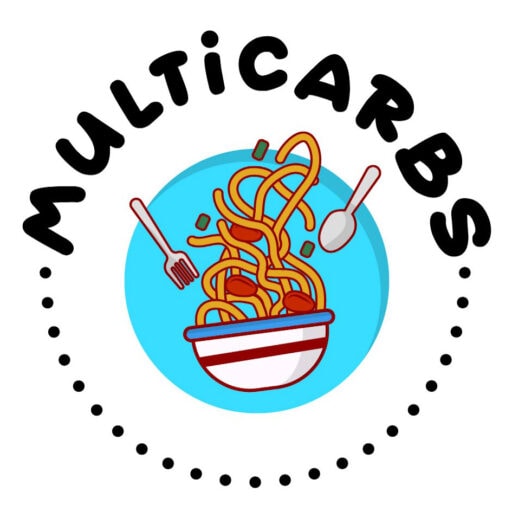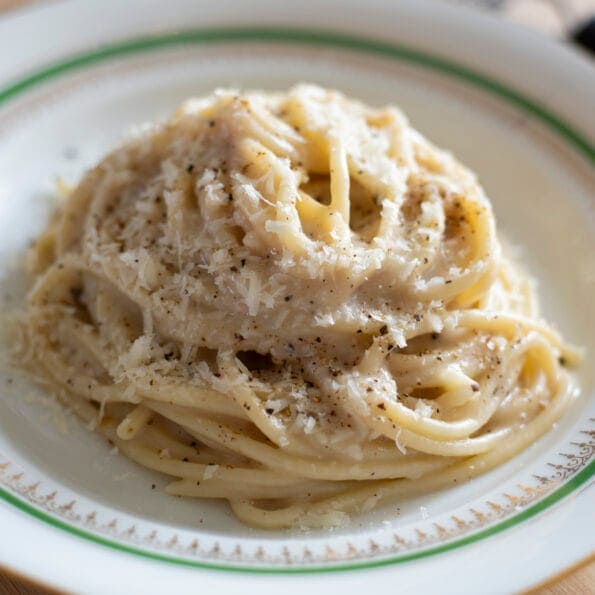
Authentic Cacio e Pepe

Authentic Cacio e Pepe Recipe
The authentic Cacio e Pepe (litterally "cheese and pepper") consists in pasta -traditionally tonnarelli or spaghetti, sometimes pici- that you drench in a sauce only made of water and Pecorino romano. Some freshly grounded black pepper lift the dish up just right.Ingredients - Advice & key points
I usually go to Eataly to get the produce I need. If you don't have one near your location, you can find fresh produce like guanciale and pecorino at your local Italian deli, maybe even your pasta. For pasta, if not available there, you should be able to order it online quite easily.- Pasta :
- While I believe tonnarelli is the best choice for this recipe, and was usually used in restaurants in Rome when I visited, spaghetti is also ideal.
- What you must not compromise on is using Bronze Drawn pasta. Why so ? Because when processed this way, the pasta will present small irregularities that will enable the sauce to cling to it.
- You could use fresh pasta if so inclined ; in this case, I'll 100% recommend making pici, which are a perfect fit for this recipe.
- Cheese(s) :
- Very important : Use some aged cheese ! If below the 8 month range, the Pecorino might be overly moist and won't melt properly.
- You can stick to Pecorino Romano only, which is the most traditional way. If your Pecorino type is strong, you might use a 70/30 blend with Parmigiano, which will tone down the strong Pecorino flavour. It depends on your Pecorino type ; if it is quite aged, in the 24-36 months range, you might benefit from adding a bit of Parmigiano.
- Careful ; only add your cheese when your fire is turned off ! Else, your sauce will turn lumpy.
- Pepper :
- It is important to use freshly ground black pepper.
- I personnally use this blend from Roellinger, but you can really use any, except highly fragrant, exotic ones.
- If you don't own a mortar and pestle, simply use the bottom of a small pot.
Recipe - What to pay attention to
- Pasta :
- Don't oversalt ! While 10g of salt/liter is usually recommended, here, with the salt from the cheese, you can easily halve this amount.
- We'll cook the pasta half of the packet cooking time in water, then in the pan with the peppery water. It is important that you taste several times starting 2 minutes before the theoretical end time, so that you get perfect al dente pasta.
- Black pepper :
- You want to toast it once ground, but don't let it burn or it'll taste bitter. Once fragrant, it's already enough.
- Pecorino :
- It is very important to thinly grate your Pecorino to that it melts properly. Look at my carbonara picture ; this is the thickest you can get. You can use a microplane or a lime zester, but if you have a kitchen robot with a really thin setting, it will also work just fine and save you the trouble.
- Do not use pre-grated cheese ! Additives are added to these cheeses so that they don't clump together, which will prevent it from integrating properly in your sauce.
- Adding your sauce : Remove your pan from heat at least 20 seconds before adding your sauce, otherwise the eggs might overcook. Then incorporate your sauce progressively.
- Plating : I highly recommend heating your plates in the oven for 10 minutes at 80°C before plating. This will prevent the sauce from getting cold too quickly and become unappealingly "set".
Cacio e Pepe is one of the most explicit lessons I got to be taught on how less is more.
Pasta, Pecorino, black pepper ; that's all it takes to make you very, very happy.
- 200 grams tonnarelli or spaghetti (bronze-drawn)
- 90 grams aged Pecorino Romano (set aside two handfuls)
- 3 grams black pepper, whole (set aside two pinches)
- 10 grams salt
- 5 pasta water ladles (adjust as needed)
- Do your grinding and dicing duty
Start heating 2L (for 200g of pasta) of pasta water on high heat.
Grind your pepper using a mortar and pestle (or the bottom of a small pan).
Grate your Pecorino Romano and your Parmigiano if using, with the thinnest grating tool you can find.
Add your serving plates to your oven on 80°C.
Please read above for any futher details on the ingredients and the way to prep them. - Start cooking your pasta
Add your pasta to the boiling water.
Add your ground pepper to a wide pan on medium heat. Let it toast around 1 minute, tossing it a bit so that it doesn't burn.
When fragrant, add 2 ladles of pasta water.
Be careful not to burn the black pepper as it will turn bitter. - Finish cooking your pasta in the pan
After half of your pasta cooking time (around 6 minutes with bronze-drawn pasta), add your pasta to the pan, using tongs.
Add around 2 or 3 more ladles of pasta water, and let it cook. Stir regularly.
- Create the sauce with Pecorino
Taste your pasta regularly.
When it is almost al dente, check your water level -there should still be around 1/2 to 1 ladle of pasta water in the pan ; if not, add some.
Remove from heat. Wait 20 to 40 seconds, then start adding your pecorino progressively, either stirring vigorously with a wooden spoon or shaking directly your pan up (see video).
Adjust the amount of water if the sauce is not liquid enough ; I usually put around 1/2 to 1 ladle when I've added half of my Pecorino.
You should remove the pasta slightly before al dente, as it will continue to cook while you add your Pecorino and adjust the water. You don't want to end up with a gooey, overcooked pasta. - Plate it up !
Take your plates out of the oven and serve your pasta immediately.
Pour the remaining black pepper and cheese over your pasta.
Et voilà ! You're done !!
Thank you for trying out this recipe ! Do not hesitate to leave some feedback. I hope it brightened your day.